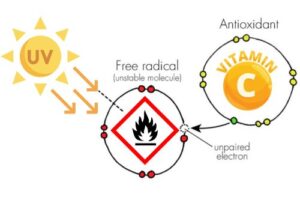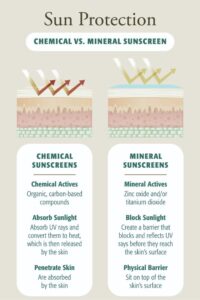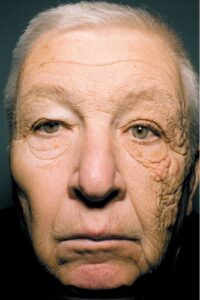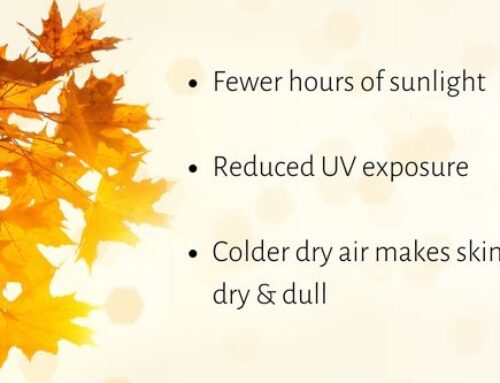With summer weather finally in full swing, we’re enjoying longer days, hotter temperatures, and higher UV indexes. This means our skin faces increased sun and UV exposure. While sunshine offers numerous health benefits, such as Vitamin D production, improved mood, and better sleep, it also requires extra care to protect against damage. Certain skincare products, particularly those with active ingredients, can increase our skin’s sensitivity to the sun. Therefore, it’s crucial to reassess and adjust your skincare routine for the summer months to ensure your skin remains healthy, radiant, and protected. In this article, we’ll highlight some summer skincare tips and discuss ingredients that are both beneficial and potentially harmful during the summer months.
The Goal of Summer Skincare
During the summer months, the primary goal of any skincare routine should be to protect your skin from radiation damage caused by increased sun exposure. Ultraviolet (UV) rays can lead to premature aging, sunburn, and even skin cancer, making it crucial to prioritize sun protection and sun damage mitigation. We all know sunscreen protects the skin from UV exposure, and Vitamin C, as an antioxidant, is one way to mitigate UV damage after it has occurred.
Sunscreen: Your Best Defense
Sunscreen is the most straightforward way to prevent UV rays from damaging the skin. There are two main types of sunscreen: chemical and mineral. Mineral sunscreens contain active ingredients like titanium dioxide and zinc oxide, which create a barrier on your skin that reflects UV light. These products often create a white-cast on the skin. Chemical sunscreens, on the other hand, contain compounds such as avobenzone, octinoxate, and oxybenzone that absorb UV radiation. Both chemical and mineral sunscreens are effective at preventing sun damage, and the best one for you is the one you will use consistently every day.
My current favorite sunscreen is a Korean brand called Beauty of Joseon. I like it because it doesn’t leave a sticky, tacky feeling on my skin.
The Importance of Vitamin C
Along with daily sunscreen, the other essential ingredient to use during the summer is Vitamin C. While Vitamin C is a great product year-round, it is especially important in the summer. As an antioxidant, Vitamin C helps mitigate damage caused by UV exposure. When UV radiation penetrates the skin, it creates free radicals, which are damaging to cells. Antioxidants like Vitamin C neutralize these free radicals, mitigating the damage. Just like nutritional antioxidants found in blueberries, blackberries, red wine, and many fruits and vegetables benefit our bodies, Vitamin C antioxidants are beneficial for the skin. The more UV exposure we receive, the more antioxidant nourishment will benefit us.

I’ve reviewed two Vitamin C products that stand out. Both contain Tetrahexyldecyl Ascorbate (THDA), a form of Vitamin C that is oil-soluble and easily absorbed into the skin.
- Vanicream: This is an affordable option and a great starting place if you’re new to Vitamin C. It sells for about $20 for a bottle that lasts 1-2 months, with a Vitamin C concentration of 5%.
- Paula’s Choice: This is my recommendation if you’re ready to commit to a Vitamin C routine. It contains both THDA and Ascorbyl Glucoside. Priced at about $60 for a bottle that lasts 1-2 months, it offers a high concentration of Vitamin C at 25%. Despite the higher price, the cost per percentage of Vitamin C makes it a good deal.
Skincare Products to Avoid During Summer
Certain skincare products can increase sun sensitivity and should be used with caution during the summer. These include:
- Alpha Hydroxy Acids (AHAs): Such as Glycolic Acid and Lactic Acid.
- Retinols: These can make the skin more susceptible to sunburn.
- Hydroquinone: This skin-lightening agent increases photosensitivity.
Glycolic and Lactic acids are excellent chemical exfoliators that promote skin cell turnover and regeneration, leading to smoother skin texture. These acids are great options for reducing the appearance of dark spots, and decreasing “chicken skin”, also called Keratosis Pilaris. However, when using lactic and glycolic acids during the summer, it’s crucial to consider sun exposure.
During the summer we experience more direct and intense sunlight. This increase in UV exposure means that the freshly exfoliated, vulnerable skin cells are even more sensitive to the sun’s harsh rays. Recent studies indicate that our skin remains extremely sensitive to sunlight for up to a week after using lactic or glycolic acids. So when it comes to summertime skincare, it’s essential to adjust your skincare routine to prioritize protection over exfoliation.
If you’re a long-time user of retinols and your skin is accustomed to them, you can continue using them if your sunscreen game is strong. However, if you’re new to retinols, summer is not the right time to start experimenting. Wait until fall.
Hydroquinone, a potent skin-lightening agent, also has similar sun-sensitizing effects. It should be avoided, or used very cautiously, during the summer. This heightened sensitivity can lead to an increased risk of sunburn and further pigmentation issues.
Hidden Sources of UV Exposure
Sunlight can be elusive! Even if you are standing in the shade, sunlight can bounce off reflective surfaces and still impact your skin. For instance, on water or snowy mountains, sunlight can bounce and cause sunburns on unexpected areas like under the chin and on the neck. Sunlight through a window won’t cause immediate burns but will lead to UV damage over time. Window glass filters the kind of UV that causes sunburns, but it does not filter the UV that causes sun damage, so if you work in an office with windows, wearing sunscreen is a must.
A striking example of the insidious nature of UV exposure is this well-known photograph of a truck driver who spent decades on the road. For several hours each day, the left side of his face was exposed to UV rays filtered through window glass, while the right side remained relatively protected. The result is a stark contrast: the left side of his face shows severe sun and skin damage, with deep wrinkles and leathery texture, while the right side remains comparatively smooth and unaffected. This powerful image underscores the importance of sun protection, even when indoors or in a vehicle, as window glass only filters UVB rays that cause sunburns, but not the UVA rays that lead to long-term skin damage.
Our skin is a vital organ that serves as a natural barrier to protect our bodies. It is essential to nourish and reinforce this protective layer, especially during the summer months. By following these summer skincare considerations, you can enjoy the sunny season while keeping your skin healthy, radiant, and protected.








